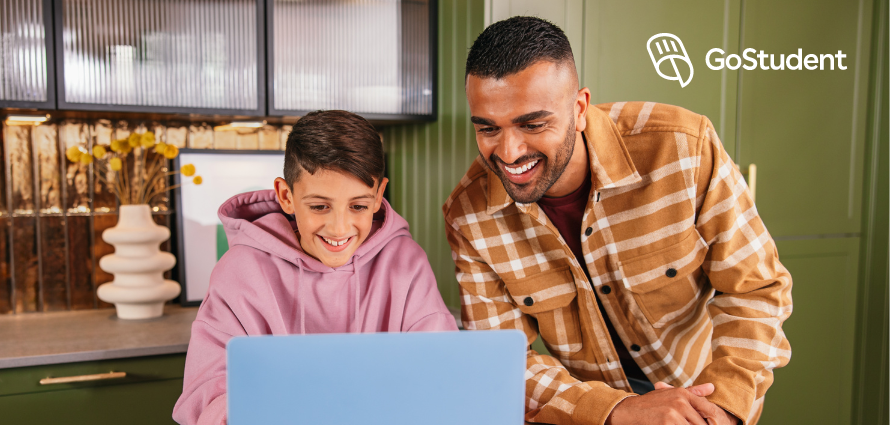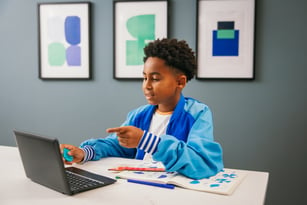When it comes to education, taking a one-size-fits-all approach isn’t the best way to arm children with the skills they’ll need for the future. This is especially the case where young ones with special educational needs (SEN) are concerned.
In The GoStudent Future of Education Report 2024*, which surveyed more than 5,580 parents and their children, and 60 teachers across Europe, looks at how digital learning impacts children with SEN. Keep reading to discover key findings from the report, along with some of the best resources for digital learning in 2024 for children with SEN.
You can read the full report here.
Contents
1. A need for personalised learning
2. The importance of new technologies
3. Online tutoring as a digital resource
4. Digital learning resources to help children with SEN
Over eleven thousand parents, children, and teachers across Europe shared their views with us for the GoStudent Future of Education Report 2024. From technology gaps to teacher shortages and AI excitement, the findings present much to consider. We’ve broken down the key discoveries from the report below.
A need for personalised learning
What the numbers say:
- Over 50% of parents think blended and hybrid learning can help alleviate school-related anxiety.
- 66% of parents also believe this mixed approach gives children greater access to learning opportunities.
- Only 6 in 10 children are currently being taught using blended and hybrid learning techniques, due to the technology gap, stretched resources, and a lack of staff training.
- Out of all children participants, 23% have been diagnosed with SEN and 26% have shown signs of SEN.
What does this tell us?
It’s quite clear from our report’s findings that a blended or hybrid learning approach, combining online and offline, in-person and digital methods, would be beneficial for children. Not only could it reduce school-related anxiety, but it may also offer children more dynamic learning opportunities and help children with SEN get the best from their education. Those dealing with SEN may not be receiving the attention they need in a classroom and as a result, can fall behind.
However, despite the numerous benefits that these more flexible learning models can offer, Europe has been slow to adopt them. This is due to the technology gap, and teachers who are reluctant to digitalise their teaching methods, favouring an in-person connection with their students.
Felix Ohswald, our CEO and co-founder here at GoStudent, says, “One trend that continues getting stronger is the demand for a more personalised education. Children have always wanted to assert their individuality, and this extends to learning. They know which methods suit them best, and combining online and offline, in-person and digital methods will enable children to learn without limits.”
Read more here about the benefits of blended learning vs hybrid learning.
Online tutoring as a digital resource
What the numbers say:
- A third of parents turn to tutors to help their child when they show signs of, or are diagnosed with, special educational needs (SEN).
- 80% of parents in the UK believe that tutoring would be a benefit to all children, not only children who are struggling.
- 9 in 10 teachers see online one-to-one tutoring as effective.
What does this tell us?
It seems there is a high demand for tutoring, especially online. As well as being convenient, online tutoring platforms use adaptive learning technology to meet the needs of all students, particularly those with SEN. Where physical classrooms can sometimes fall short for students with SEN, online platforms provide them with a tutor who can tailor lessons and, most importantly, give them the one-on-one focus they need.
If you think your child would benefit from online tutoring, we have a wide range of fantastic, qualified tutors to choose from. We match the needs of your children with their ideal tutor and let the magic happen. Why not book a free trial lesson today and see for yourself?
The importance of new technologies
What the numbers say:
- 89% of UK children enjoy learning with digital apps.
- 8 in 10 children state they already use digital apps to support learning.
- 83% of children in the UK enjoy learning with AI.
- 80% of children embrace online learning tools.
- Almost 7 in 10 children use a computer at school in the UK.
- 50% of children want to learn more using VR and AI.
- 8 in 10 teachers agree that technology and digital tools allow children to learn at their own pace.
What does this tell us?
Our report states that 1 in 5 children have been diagnosed with, or show signs of SEN and require unique attention. With new technologies such as AI set to boost adaptive learning, it’s more important now than ever for teachers to feel confident enough to implement new technologies into their teaching methods.
Despite the doors that technology opens for students — not only in academia but also in the workplace - there’s still a clear technology gap, with only 7 in 10 children having access to computers at school. Unfortunately, this means that some children are at risk of not developing sufficient digital literacy skills and falling behind their peers.
This also emphasises the need for blended or hybrid learning to be implemented in education. For students who don’t have access to a computer at school, they could use a computer at home and learn to become digitally literate with the help of parents, online tutors, and digital learning websites.
“The pandemic accelerated the integration of technology and digital learning, and the recent explosion of AI has given children access to a multitude of new tools that support and inspire their learning journey,” says Felix. “As an advocate for technology-enabled education, I’m excited by the progress I’ve already seen, and the new opportunities each advancement unlocks. Children want to learn about topics that prepare them for the future, including AI.”
Digital learning resources to help children with SEN
What the numbers say:
- 9 in 10 teachers praised the effectiveness of learning through digital apps, but only half regularly use them.
- 56% of children in Europe expect their future jobs to be directly related to technology.
What does this tell us?
With 56% of children expecting their future jobs to be in the field of technology, we must support children now so that they have the skills they need to flourish in the future. It’s also crucial to help children with SEN with their studies, not only to prevent them from falling behind but also to give them confidence and a drive to learn.
Here are seven digital learning resources that can help children with SEN shine.
- GoStudent
We’d be remiss if we didn’t recommend ourselves to help boost your child’s knowledge and academic skills! Not only do our tutors cover all the core subjects, but we match every child’s needs to the right tutor to create an ideal match. Plus, did we mention that we now do lessons in VR? Your kids can now learn four times faster with the help of virtual reality — discover GoStudentVR.
Find out here what makes our virtual classroom unique.
- Seneca
If you want your child to learn two times faster thanks to smart learning algorithms, head over to Seneca. A destination filled to the brim with learning resources for KS3, GCSE, A Level, and 11+, to name but a few. Seneca is fun, fast, and free!
- Baamboozle
A website filled with games made by teachers, Baamboozle is packed with fun activities for kids to enjoy. Simply search for the subject/topic you want to practice — for example, “irregular verbs” — and an assortment of games to practice that grammar point will appear. Totally fun and totally free — what more could you want? - TED-Ed
One for older children, TED-Ed boasts a seriously impressive catalogue of educational videos. You can search and filter by subject and school level and wait as the most fascinating videos roll up. One quick look in the Algebra section uncovered videos titled “The mathematical secrets of Pascal’s triangle”, “How does math guide our ships at sea?” and “What's the difference between accuracy and precision?”. Great for parents and teachers too, we highly recommend this treasure trove of knowledge. - TikTok
You’re not reading this wrong — TikTok is believed to be an excellent learning tool. Why? Its engaging, bite-sized videos offer a new way for young people to digest new knowledge.
In a 2022 review, it was concluded that complex topics like chemistry, which can often be found boring, were being taught via TikTok videos in a fun and engaging way. They even led to students carrying out simple experiments using materials found at home. Other subjects that TikTok seemed to make learning more enjoyable were sports science, English, and dance.
In fact, in May 2020, the social media platform launched its initiative #LearnOnTikTok, recognising the high demand for educational content among young people.
If you’re a teacher who’s keen to find some new materials, here are our top TikTok accounts for teachers and tutors.
Online tutoring can be a transformative journey in our child’s education. It can enable them to stay on top of classwork, offer specific help if they need it and even gives them the chance to learn more about their favourite subjects. There are only five steps to finding the right tutor for your child, so book a free trial today!









